Report

Introduction
For the past seven years, Bain & Company has researched how and why the career paths of women and men differ. In this report, we examine the lessons learnt from previous studies and look for opportunities to apply them to better address gender parity in the South African workplace.
The current statistics in South Africa do not paint an ideal picture: In 2017, 31% of South African companies have no female representation in senior leadership1 roles. The latest Businesswomen’s Association of South Africa (BWASA) census on women in leadership indicates that 22% of board directors are women, but only 7% are executive directors. Furthermore, only 10% of South African CEOs are women, and if we look solely at companies listed on the Johannesburg Stock Exchange (JSE), this number drops to 2.2% according to the BWASA census. Overall, the percentage of women in senior leadership roles has been relatively flat, with representation increasing slightly from 26% in 2004 to 28% in 2017. South Africa is on par with the rest of the African continent, where 29% of senior leadership roles are held by women, and performs better than some developed countries, such as the UK (19%) and Australia (23%). However, the percentage of CEOs who are women in South Africa (10%) is lower than the global average of 12%. Representation matters, as studies suggest that for minorities to have their voices heard as an influential body and not as a token, this figure needs to be 30% or higher.
This stable trend in South Africa is unfolding despite a foundation of positive influences supporting gender equality in the South African workplace, at both the country and corporate levels: The country’s constitution and the Employment Equity Act, No. 55 of 1998 aim to promote women’s participation in the private and public sectors, while the JSE now requires boards to publish their gender diversity strategy and, if they set voluntary targets, to report on progress achieved in meeting those targets.
As a country, we have more women graduates than men, and our research shows that South African women in the corporate environment have a strong desire to succeed. Crucially, as we discuss later in this report, most women are as likely as men to aspire to senior leadership positions and are as confident as men that they can achieve those heights.
Given that the foundational elements to ensure success appear to be in place, we must ask the question: Why are so few women reaching senior leadership positions in South Africa?
Bain & Company’s inaugural research project on gender equity in South Africa sought to answer this question.
We surveyed more than 1,000 women and men in JSE-listed and private organisations, spanning non-management positions through to board-of-directors level. We combined our survey data with more than 50 one-on-one interviews and in-depth analyses with several leading South African organisations.
In this report, we share current perceptions of gender equity in the South African workplace and the deterrents to success that women must confront daily to succeed. We also present several practical recommendations that society, organisations and individuals can implement to shift the status quo.
Setting the scene for gender mainstreaming in South Africa
The Employee Net Promoter Score® and company advocacy
The Employee Net Promoter Score (eNPS) is a measure of employee advocacy (see below “Employee Net Promoter Score explained”). A low eNPS presents a challenge to companies for three primary reasons: It negatively affects company performance, it heightens the flight risk of talent and it deters future talent from wanting to join the organisation.
Our research indicates that South African women are much less likely than men to recommend their organisation as a place to work: The overall eNPS for women is negative 4 compared with 8 for men. In other words, more men would recommend their organisation than those who would not (positive eNPS). In contrast, more women would not recommend their organisation than would promote it (negative eNPS). The survey also revealed that women—particularly those included under Broad-Based Black Economic Empowerment (B-BBEE), those at more junior levels and those within certain industries—are significantly less likely than their male counterparts to recommend their organisations to a friend or colleague (see Figure 1).
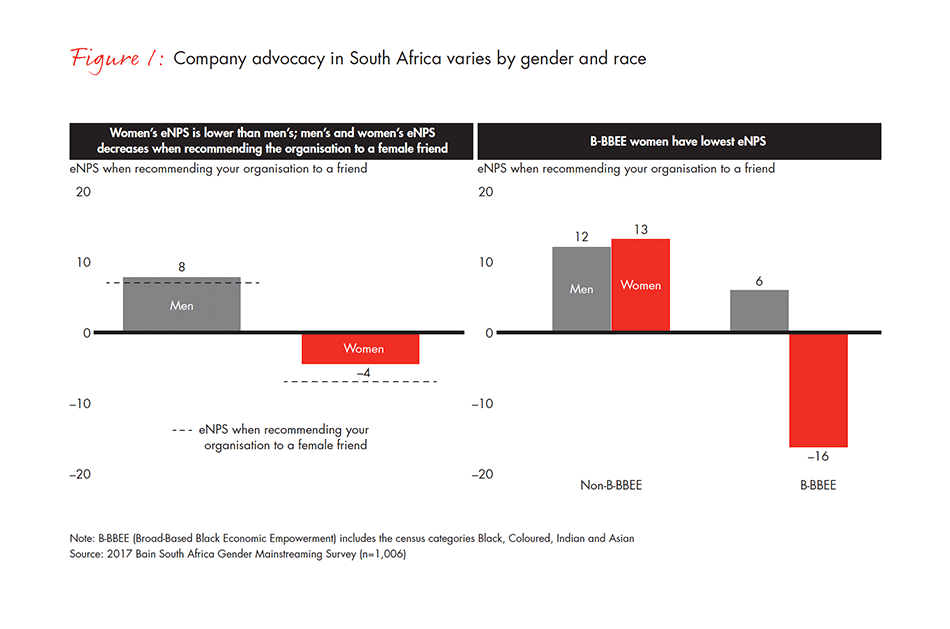
The wide disparity when viewing eNPS by race highlights the importance of intersectionality when thinking about gender equity and understanding that the experience of one woman is not the reality of all women, especially given South Africa’s past. Among others, race, sexuality, language and religion all play a role in individual experiences in the workplace, where numerous conscious and unconscious biases come into play.
As one non-management respondent explains, “It’s important to note that intersectionality exists…I am a black woman: I am not a woman on some days and black on others, I am both at the same time. For me, promoting gender equality in the workplace is irrelevant if it doesn’t also promote racial equality at the same time.”
Seniority also matters. There is a clear increase in eNPS for both men and women as seniority increases, but it is only at the executive level where we find more men and women are promoters of their organisation rather than detractors, and a positive eNPS: For women, eNPS increases from negative 17 at the non-management level to 38 at the executive level; for men, it increases from 3 to 39. This stark difference highlights the need to improve the overall environment for women as they enter the workforce to retain them through the executive level.
Our research also indicates eNPS for women varies across industries. For example, eNPS for women in the banking, finance, industrial and mining sectors ranges from negative 15 to negative 23, whilst eNPS in the professional services, manufacturing and property sectors is higher, ranging from 10 to 38.
Aspirations and confidence: No gender divide
Our research uncovered that South African women aspire just as much as their male counterparts to reach senior leadership positions, and they are as confident as men that they will achieve their goals (see Figure 2). Given the gender imbalance at the senior and executive levels, where women represent only 7% of executive directors on boards, even though 46% of people entering the workplace are women, this finding is significant.
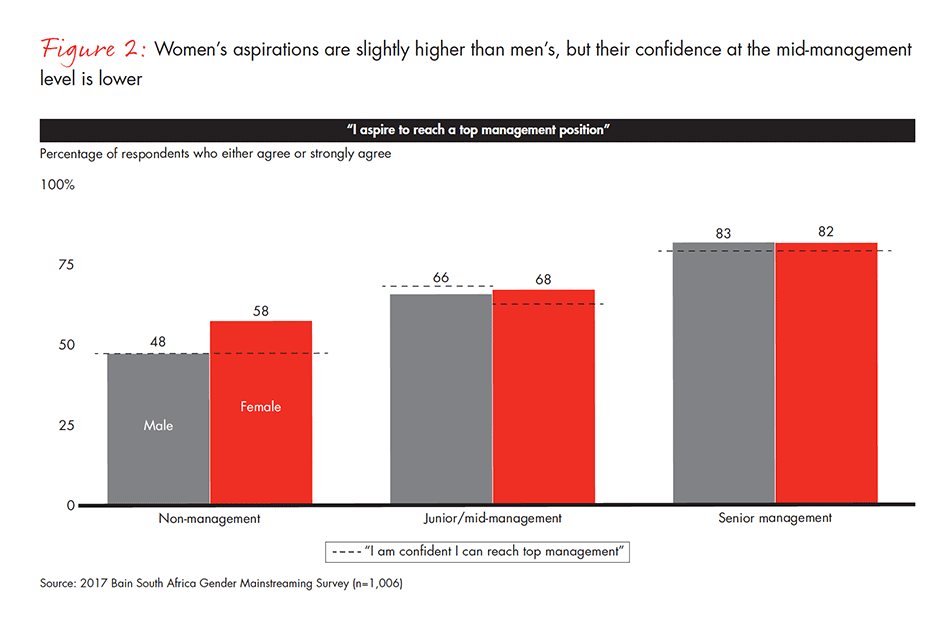
This phenomenon may partly be explained by the apparent loss of confidence amongst women in junior- and middle-management positions that they can rise to the top. We found women at this level are, on average, 11% less confident than their male counterparts.
One senior-level woman we interviewed explained that it is often at the middle-management level that women start to experience the realities of gender (and, in a South African context, racial) inequality: “When I started, I felt like I was on an equal footing with my contemporaries, but in retrospect I was still sheltered from the real issues in the corporate world. As I climbed the ladder, it became trickier, and I came to realise that there are political imbalances that I, as a black woman, need to navigate to progress that men around me do not face. In cases where my male colleagues face similar challenges, they have access to a sponsor or mentor (normally of the same sex and colour) to help navigate these issues.”
Just as this gap in confidence between men and women clearly materialises in middle management, our research finds that women who do not aspire to senior leadership positions make that decision once they have been employed for two or more years—not before joining the workplace, as is commonly cited. Three factors are cited by women as reasons not to aspire: misalignment with career aspirations, a lack of confidence and an inability to balance career and family. The latter is a factor that women are almost twice as likely as men to cite, yet it is not the most important factor they name.
Gender equality beliefs
In addition to better understanding the effect of aspiration and confidence, another critical aim of our research was identifying to what extent employees believe in gender equality in the workplace and—more importantly—the primary causes for that belief.
Our research uncovered that most respondents believe that gender equality in the workplace is important, with roughly 80% of senior management and executives—both men and women—indicating that they are fully convinced of the benefits of gender equality (see Figure 3). This positive outlook comes with a substantial caveat, however, when the performance implications and strategic imperatives of gender equality in the workplace are pressed.
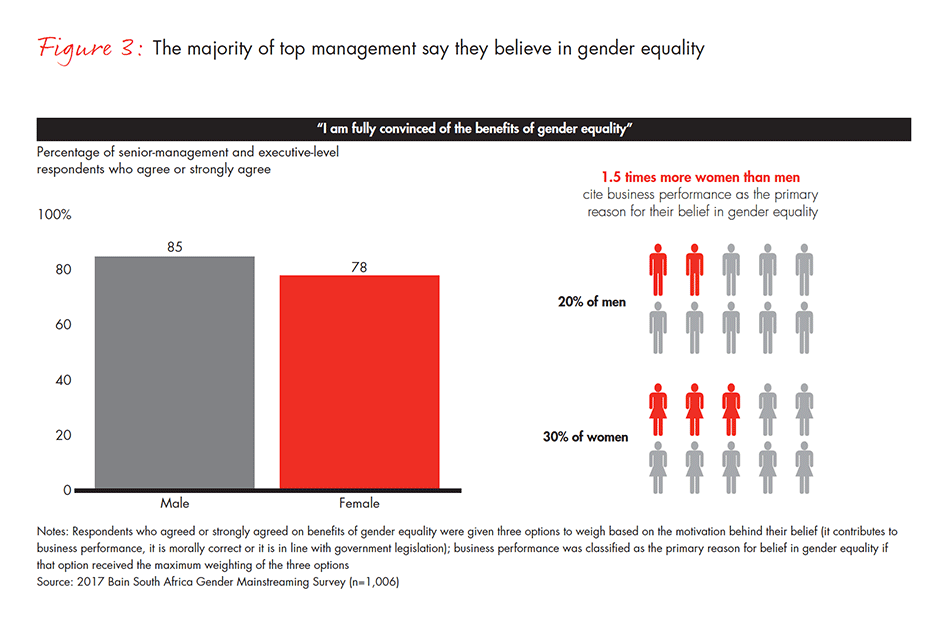
When asked to choose the primary reason for their belief in gender equality (i.e., which reason they assign the greatest weight) amongst moral imperative, government legislation and business performance, only 20% of men cite business performance. Women, however, are one-and-a-half times more likely than men to cite performance. Looking solely at the executive level, the numbers between men and women follow the same trend, with women citing organisational performance significantly higher than their male colleagues as the main basis of their views on gender equality (38% for female executives vs. 24% for male executives).
Despite the higher numbers seen for women, it is still worrying that on average fewer than 30% of all respondents consider business performance to be the primary reason why they believe in gender equity. For us this indicates that more work is needed to communicate the strategic business importance of gender equity in the workplace.
Even though the vast majority of respondents view gender equity as a strategic priority, particularly at the senior level, until there is sincere recognition of how gender equality influences business performance, true progress in the workplace is unlikely. Businesses may achieve gender targets, but they will not have created the appropriate environment for women to thrive.
Truths and myths: Gaps between women and men in the workplace
We tested 12 commonly cited factors that affect women’s career progression across societal, organisational and personal lenses (see Figure 4).
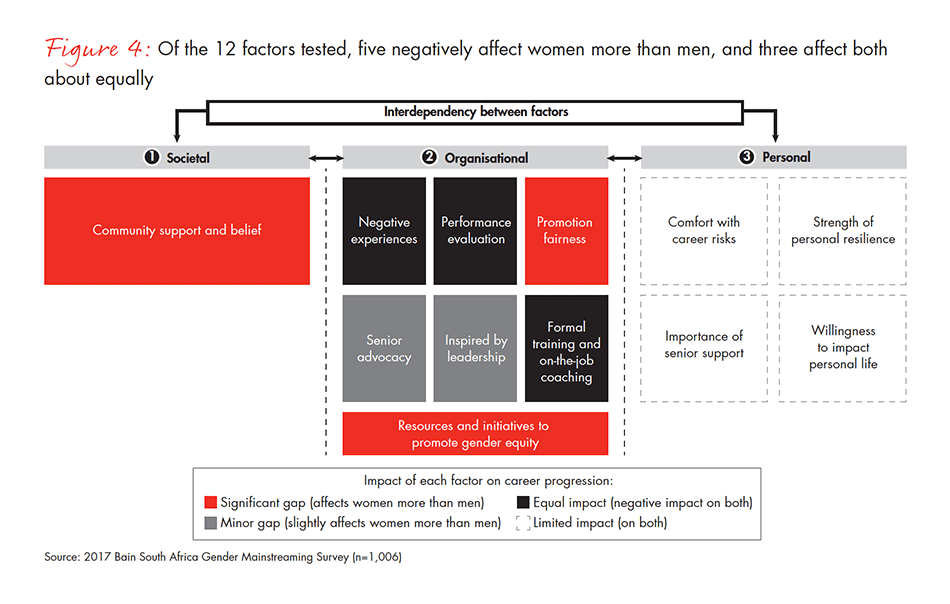
Societal factors
Truth 1: Societal factors matter
Deeply embedded societal norms mean that women in South Africa who aspire to reach senior leadership positions feel that they are going “against the grain.” We found that only 58% of survey respondents said that their communities believe in equal opportunities for men and women, while 63% of respondents believe that men to whom they are close have no problem with women earning more than men (see infographic). Interestingly, this perception varies significantly across racial groups and, therefore, the extent to which different women experience societal pressures. Within broader communities, black women are up to 1.6 times less likely than their white counterparts to believe that men to whom they are close have no issue with women earning more money than men.

Shaking South Africa's Social Norms
Despite changing social norms, many women still feel that they're going against the grain. Here's a look inside the numbers of gender parity in South Africa.
Our research also revealed that the beliefs held by one’s immediate family have a strong influence on women’s aspirations. Roughly 80% of female respondents agree that their families support equal career opportunities for men and women (significantly higher than broader communities) and there is little variation across racial groups. However, those women who said they do not aspire to senior leadership positions are almost three times as likely to say their families do not believe in equal career opportunities for men and women. This suggests women continue to bear a disproportionately heavy burden when it comes to balancing work and family life with societal norms, which continue to dictate that women be the primary caregivers in the home.
In summary, deeply embedded societal norms continue to actively discourage women who aspire to ascend to senior management positions from reaching their full potential. It is crucial that we continue to tackle gender biases and redefine gender roles at formal places of education, within our own households and within our broader communities.
Organisational factors
Companies must take steps to address the organisational factors that affect gender equity to create an environment in which women can thrive and the organisations that employ them are able to enjoy the full potential of diversity.
Truth 2: Organisational culture and negative workplace experiences shut both women and men out, especially at junior- and mid-management levels
Negative experiences such as sexual harassment and lack of inclusion are, amongst others, discouraging factors to both women’s and men’s career advancement, particularly for those in junior- and middle-management positions. About 40% of women as well as men have negative experiences more than once a quarter, suggesting these are issues that cross the gender divide (see Figure 5). However, based on our interviews, it appears that these negative experiences have a more significant effect on women’s advocacy/eNPS, desire to stay in the organisation and likelihood to move up the ranks. We found that, broadly speaking, women do not feel that they are part of the organisation in the same way as men do, often because they are subjected to disrespectful behaviour or, in some instances, criminal actions such as sexual harassment. This disenfranchisement particularly affects those at non-management levels, discouraging women at a key career point from ascending within the company ranks.
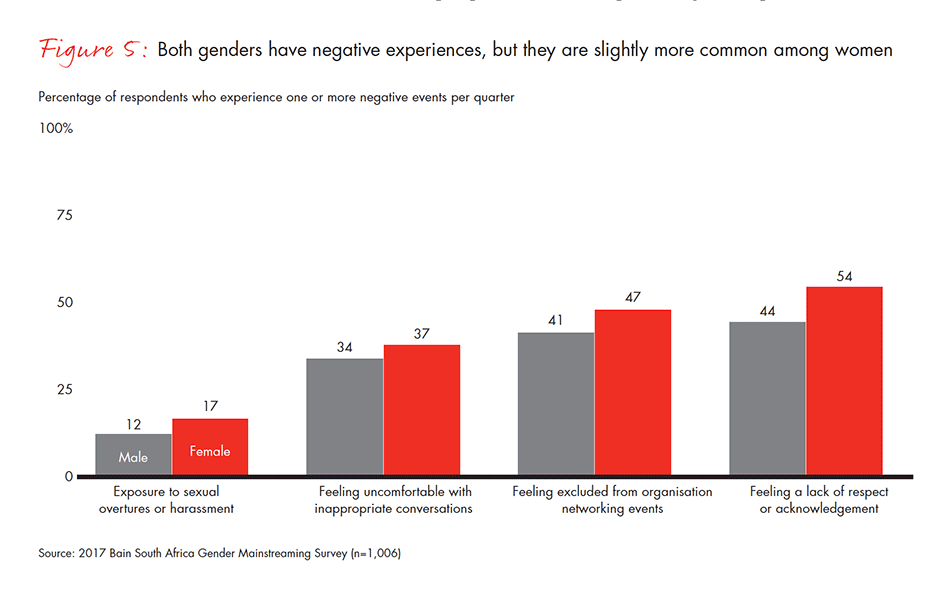
Our research indicates that instances of sexual harassment in the workplace are alarming; its pervasiveness, and how it is dealt with, can influence advocacy/eNPS. Of the women we surveyed, 17% said that they experienced sexual overtures or sexual harassment at least once per quarter, with 6% experiencing it once per month or more.
Further, organisations often do not sufficiently support their employees in these situations, or create an environment in which employees feel comfortable coming forward. As one woman in senior management explains, “Sexual harassment is very common in my company. There are men who have had several sexual harassment grievances laid against them, yet they still work for this company and continue to demand sexual favours from various colleagues. Because of this, women are afraid to come forward.”
Exclusion from company networking events is a key factor driving “middle-management permafrost”: The employees who seem to achieve the greatest success in their careers are those who have access to the inside track of what is discussed outside meetings. In fact, as a non-management level female respondent explains, “Many of my company’s informal networking events are tennis, golf and soccer with the partner team, all of whom are men. This makes me feel left out as I am losing out on valuable social networking time with the leaders of the firm.” Furthermore, there is a perception that key business decisions are made outside of the boardroom. This way of conducting business disproportionately excludes diverse individuals, particularly women in middle management, who are seeking to move up in the organisation.
As we look at ways to address these negative experiences, it is important to foster a culture of zero tolerance, and to build a safe space for both women and men to share their experiences within the organisation to raise awareness. Through one-on-one interviews we found that, in many cases, executives are unaware of the prevalence of these negative experiences, and the effect they have on employees.
Truths 3 and 4: Performance evaluations and promotion timelines are perceived as biased towards men, particularly at the non-management, junior- and middle-management levels
Our research indicates that women feel that some of the processes currently in place in their organisations disproportionately benefit their male colleagues. For example, women are approximately 30% less likely to believe that they have equal opportunities to advance on the same timeline as men, with the largest disparities occurring at the junior- and middle-management levels, where men are 46% more likely to believe in equal promotion timelines (see Figure 6).
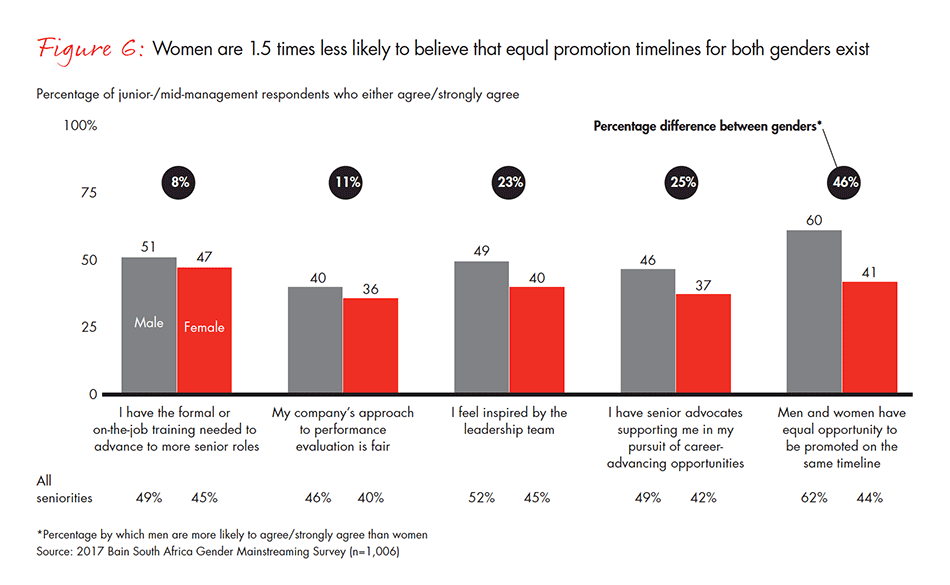
Our research indicates that the perception of fairness in performance evaluations is problematic for both women and men. More than half of all respondents (in all but the executive committee [ExCo]) agree performance evaluations are unfair; however, this perception is more pronounced for women across the board. To encourage diversity, it is important that organisations address these perceptions and identify any biases in their current systems and processes to minimise their impact.
Truth 5: Women lack advocates/sponsors at senior levels to support their careers
Sponsorship of individuals, especially at the mid-management level, ensures that contributions and performance are recognised and attributable to the individual. Often, women, particularly in middle management, feel marginalised, ignored or simply worn down by trying to get their efforts recognised. As a consequence, promotions generally take longer and the loss in confidence is reflected in the decline in advocacy scores by women a few years into their careers. Unfortunately, our research indicates that most women do not feel that they have the senior-level support necessary to achieve their full potential. Although the percentage of women who feel that they have senior advocates supporting them in their careers increases with seniority, this growth originates from an exceedingly low base. Fewer than 40% of women in non-management, junior- and middle-management positions believe that they possess such support.
Our research also suggests a gender gap in how men and women responded to this question. We found these numbers to be significantly lower for women than for men at the junior- and middle-management levels, but the gap begins to close once employees reach senior management level. A lack of senior advocates is the common thread that links several of the organisational factors we discuss that appear to lead to a disadvantage for women.
As one female executive explains, “It really all comes down to having senior support in the organisation, irrespective of their gender. Without senior advocates or sponsors supporting and advising you, you are highly unlikely to reach your full potential. Sponsors should be able to ensure performance evaluations reflect the full contribution of the individual (removal of implicit or explicit bias), and a reduction in risk of marginalisation or isolation of an individual. Consequently, if sponsorship is not present and effective, the individual is less likely to take risks and be resilient, because there is no one there to support you.”
This especially influences women at the middle-management level, particularly when accounting for the “middle-management permafrost.” For example, a lack of senior support reduces the likelihood of a woman being promoted, where senior voices in the room are often the swing factor between two candidates.
Truth 6: Women are less inspired by their leadership teams than men are
Being an inspirational leader is becoming increasingly important because targeting inspiration drives greater commitment, satisfaction and productivity, as well as lower attrition. Three changes in particular have elevated inspiration to the forefront of most companies’ agendas:
- Shift in focus. A shift from product to customer experience as a major source of competitive advantage is occurring, even in product-focused companies.
- Change in nature of the work. Individuals must self-motivate to do their best work, and they must share that passion with others on their team and in their company.
- Emerging millennial generation. Employees are motivated because they believe in their company’s mission and values, not just because they hope for a sizeable salary or quick promotion. For millennials in particular, their sense of “what’s in it for me?” is more likely to be defined by learning and engagement than by traditional motivators.
Creating inspiration, whether through leaders or through investment in the employees themselves, is now essential for attracting and retaining the best talent.
Our research shows that only 45% of women are inspired by their leadership teams, compared with 52% of men. The disparity between men and women is most apparent at the middle-management level, where men are 23% more likely than women to be inspired by the leadership team. Although our interviews revealed that women were less likely to find a leadership team inspiring if it lacked female role models, several women spoke of male leaders they found inspiring.
Bain & Company’s experience has demonstrated that the ability to inspire is not innate, but it can be developed. We found that anyone can develop the ability to inspire through the discovery and cultivation of his or her inherent talents. Bain & Company’s Inspirational Leadership System includes structured reflection and input from 360-degree surveys and self-assessments to help individuals on this journey. To find out more, visit www.bainleadership.com.
Truth 7: A lack of formal and on-the-job training limits the ability of both women and men to advance in the workplace
Training and coaching, whether formal or on-the-job, are arguably amongst the most practical means by which people feel that their organisation takes a vested interest in their professional and personal growth. A lack of suitable and effective coaching and training leaves employees ill-equipped to take on and succeed in more senior roles. Our research has shown that roughly 50% of both men and women believe they receive the training and coaching necessary to advance to more senior roles.
This figure is particularly low at the non-management level, where only 31% of women and 38% of men agree. This finding should be a major concern for organisations as these groups represent the talent pipeline. Setting these groups up for success through adequate coaching and training not only ensures that employees self-actualise, but it also facilitates their collective desire to aspire to top management positions within the company. Furthermore, our data shows that women who receive adequate on-the-job coaching and training are two times more likely to aspire to top management than women who do not.
Truth 8: Companies’ efforts and solutions are ineffective in the eyes of the women they are trying to support
Appearances matter. Less than half of the women surveyed believe that organisations have made gender equity a visible priority, and the gap between men and women is wide (39% of women vs. 58% of men). Not surprisingly, the belief that gender concerns are a visible priority increases with seniority among men and women.
Further, more than half of male executives believe that the organisation has dedicated sufficient resources to gender equity efforts, whilst only 40% of female executives believe that the current resource allocation is sufficient.
This discrepancy is reflected in the fact that the uptake of options to support women was extremely low. Our survey found that women strongly value five specific types of support in the workplace: flexibility, mentorship, apprenticeship, sponsors and a clear sexual harassment policy. Employees say that these support structures are available, but the use of such tools is low, with one-third of respondents believing that these initiatives are available and widely used (see Figure 7). For example, 70% of women agree that flex options would be helpful in achieving gender equity, yet only 31% of the respondents feel that flex work is a widely-used option. This finding suggests that companies are either focusing on the wrong initiatives or are not implementing these initiatives correctly.
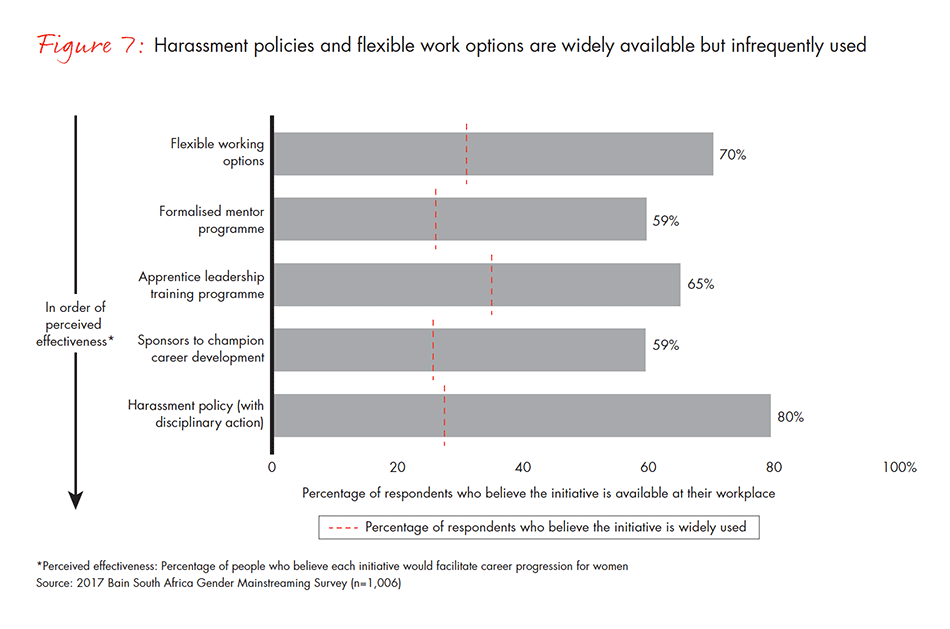
Companies must ensure that they promote available initiatives and effectively communicate them to ensure efficient uptake. Moreover, companies must successfully implement, track and provide leadership support for these initiatives through adequate budgets and behaviour change initiatives.
Personal factors
Myths 1–4: Differences in personal traits between men and women explain the scarcity of female executives
In contrast to commonly-held perceptions, we found little difference regarding the effects of personal traits on career ascension across genders. Our research zeroed in on four areas: strength of personal resilience, the importance of senior-level support when pushing for opportunities, comfort with career risks and willingness to affect personal life in pursuit of career advancement.
We categorically busted the myth of these personal attributes being a key factor holding back women’s careers. Both male and female survey respondents scored their experience within these categories nearly identically and reasonably high, at an average of 3.8 out of 5. This finding highlights the importance of challenging misconceptions of personal factors acting as barriers and preventing women from reaching positions of leadership.
Interventions required at the societal, organisational and personal levels to address gender equity
Given the findings of our research, we then focused our efforts on how we should go about improving gender equity in the workplace, offering specific recommendations to shift the status quo in South Africa (see Figure 8). We concentrated on the same three factors we looked at in the diagnostic: societal, organisational and personal.
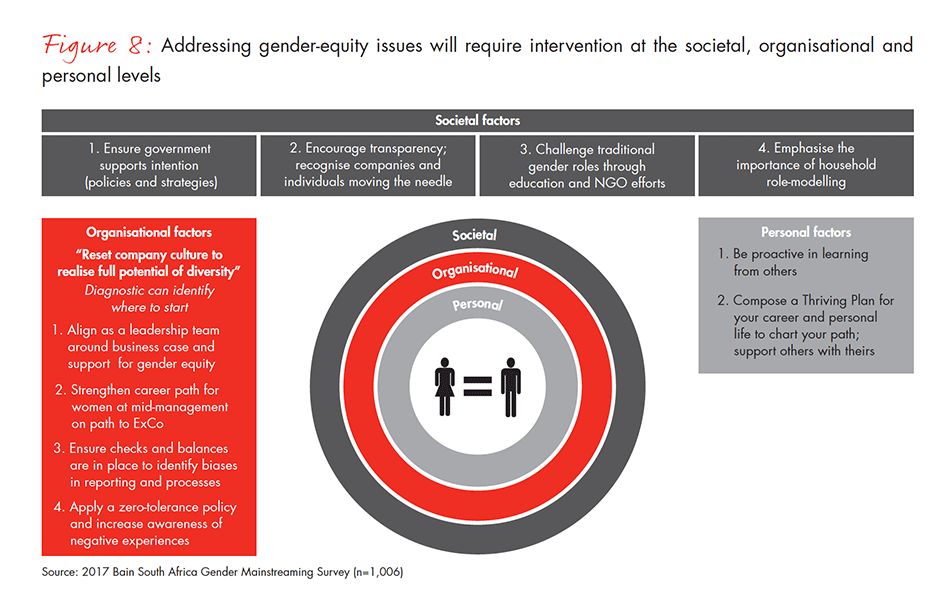
Recommendations for society at large
Our research pinpoints four key actions societies should take to combat gender inequality:
- ensure government support of intentions to reach gender equality (policies and strategies);
- encourage transparency by recognising companies and individuals that are moving the needle;
- challenge traditional gender roles through places of education and non-governmental organisation (NGO) efforts; and
- emphasise the importance of household role-modelling.
Society—including government, investors, broader communities and families—has a direct influence on the role of women in the workplace.
In many instances, the active role government has played in setting policies and standards has been key to moving the needle on gender equity in the boardroom. For example, after introducing quotas, Norway—now recognised as the leader in gender equity in Europe—boasts 42% female board representation. The UK, following recommendations from the government-commissioned Davies Review, established targets for female representation at the board level; as a result, female board representation now stands at 26%. The UK government then commissioned a second exercise—the Hampton/Alexander Review, which has set a goal for the Financial Times Stock Exchange 100 Index companies to achieve 33% female representation on the combined ExCo and direct reports to executives by 2020. Closer to home, Rwanda’s government has taken the lead on the gender equity agenda, with a strong emphasis on challenging gender-based violence and encouraging girls to attend school. Bright spots of progress reflect this government support: Rwanda was the first country in the world to have 50% female representation in its parliament, women have the same property rights as men, and girls have the same access to all levels of education as boys.
Despite these successes, there are mixed views of the merits of charters, fixed targets and quotas. In South Africa, at a minimum, we must recognise and reward organisations and individuals who are making progress on this front. The Netherlands is a strong example of this. The government endorsed a “Talent to the Top” list (now run by D&I Company): More than 200 top Dutch companies committed to gender equity by signing this pledge. Since its inception, female board representation has increased from 7% to 21%.
Activist investors—who are increasingly important players in society—are making the case for gender equity: Hermes Investment Management incorporates environmental, social and governance risk into investment decisions, which includes gender diversity. Furthermore, media publicity for organisations and individuals who are leading the charge on gender equity is increasing. For example, BHP Billiton enjoyed positive media attention when it published its goal of having 50% women in the workforce by 2025, which was spurred by the undeniable business case for gender equity. Will we see something similar in South Africa?
It is also important to foster change from the bottom up by reaching out to the next generation. Tackling gender roles through education in schools in South Africa is a powerful approach for challenging the traditional roles of men and women in society. Conversations in the classroom have an important role to play in shifting the status quo. In several cases, joint efforts between NGOs and government organisations have provided an impetus for this bottom-up change. In 2006, Spain passed a law requiring that the core curriculum for secondary education include the recognition and identification of gender inequalities and the promotion of gender equity in society—that is, family, the workplace and other spheres. Closer to home, NGOs are playing a key role in changing perceptions. For example, Transform Education About Rape and Sexual Abuse (TEARS), a Johannesburg-based NGO, is seeking to create awareness and transform attitudes about sexual abuse. These efforts will continue to be essential for creating change from the bottom up.
Last but not least, one’s immediate familial context has a crucial role to play in advancing gender parity, by creating household role models (both men and women) that challenge traditional gender stereotypes. The conventional roles of children in the home also need to be reimagined. As our research found, in South Africa family support has an influence on ambition. Women who do not aspire to top leadership are approximately three times more likely to say that their families do not believe in gender equality than women who do aspire to these roles.
A male CEO we interviewed explains: “My sister is arguably more successful than I am, and I believe this has a lot to do with how we were brought up. My parents treated us exactly the same…We were both expected to help with chores, and we were both expected to bring an interesting topic of conversation to the table for lunch.”
Gender equity in the workplace touches on a broader theme of gender equity in society. Holistic efforts are required if we are to create positive change. As our survey results revealed, we still have a long way to go before communities fully believe in equal career opportunities for men and women. Changing beliefs takes time and requires a conscious effort by individuals to create change, but many success stories show where improvements have been made. South Africa’s unique history will influence how these can be applied.
Recommendations for organisations: Common calls to action
In developing this research, we worked closely with several organisations to set each one’s gender agenda. We found that companies are at varying stages in their respective journeys towards achieving gender equality. Their point of departure (i.e., the status of the gender gaps) and the relative priority in which they should be addressed differ from company to company. To help each organisation define its primary challenges, Bain & Company developed a diagnostic tool to identify key factors that affect women in the workplace, and pinpoint where companies can begin addressing issues of gender equity (see Figure 9). It is crucial that companies treat efforts to achieve gender equality with the same rigour and deep pragmatism they would any other change effort.
There is no silver bullet to fix gender equity in the workplace. However, we found four calls to action that were applicable to all companies and could, when implemented, positively affect women’s confidence and achievement in the workplace (see Figure 10). These actions are targeted at resetting the current company culture (which was in most cases developed with men in mind) to drive the full potential of diversity. In the sections that follow, we describe a number of sample initiatives that companies could implement to meet these goals. Using the diagnostic tool, companies can determine where to differentially invest their time based on what matters most to them.
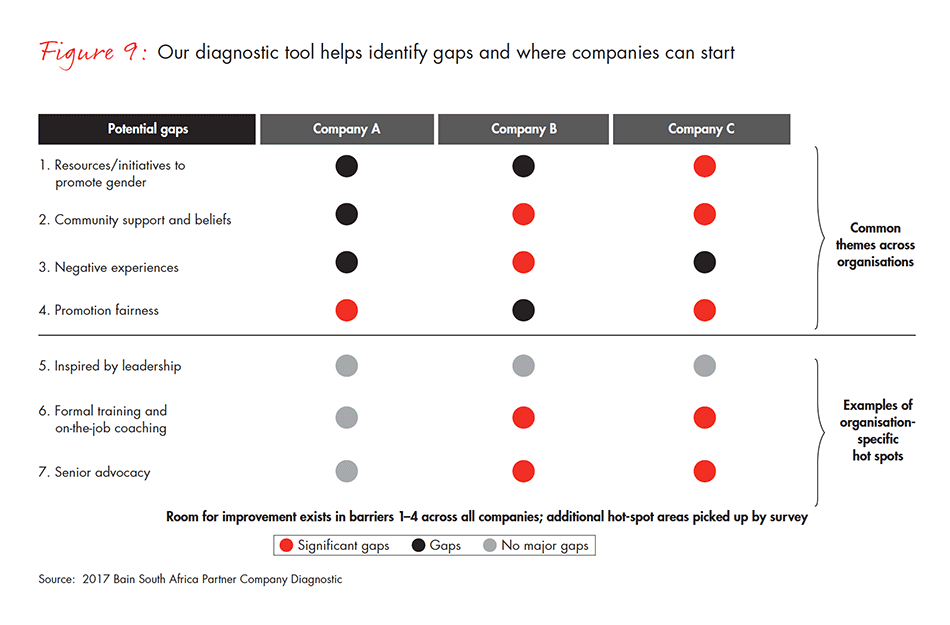
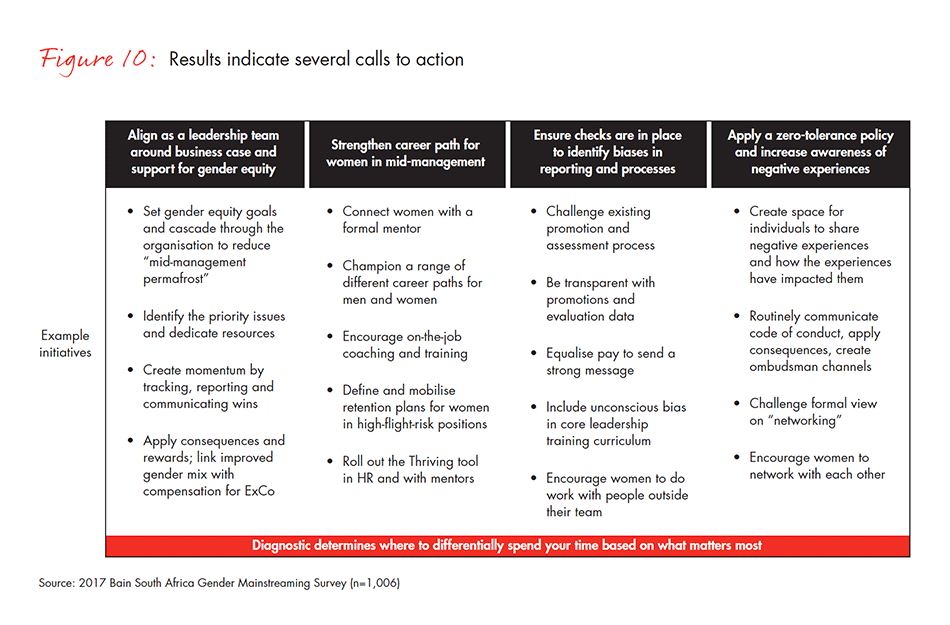
Align as a leadership team around a business case that supports gender equity
As a first step towards achieving gender equality, organisations must be committed to change, with a clear ambition and business case as well as full leadership support. Importantly, a leadership team’s focus on gender equity should not be treated in isolation to other diversity efforts, which in South Africa, should already be high priority for the majority of companies. We outlined four initiatives to help organisations achieve this goal, with the first point described in more detail here.
An ExCo led by the CEO (see below “The CEO is fundamental in fostering gender equity”) should come to a consensus on your gender equity ambition and goals. Promote this message from the top down, ensuring that you inspire middle management to take action. Successful change efforts have three elements in common: clear ambition, aligned leadership and the ability to cascade the message through the organisation. We identified several steps through our research to achieve this goal:
- Create the business case for diversity in your organisation. Use data and examples externally and internally to showcase the benefits whilst at the same time understanding that there might be resistance to change.
- Where possible, have men champion this idea, not just women. Doing so helps prevent a “them vs. us” mentality. Most times, men are happy to support the cause, although the best way to do this is often unclear. As a male chairman and former CEO of a South African organisation explained, “It’s too risky for small minority groups to push the agenda forward. You need people established in their role (i.e., with authority) to champion the change agenda; this is why men, who take up the majority of senior positions, are fundamental in this journey.”
- Make the CEO and ExCo commitment to this visible. Set multiyear ambitions with annual targets, and lead by example. It is also important to ensure that those ambitions are communicated to every level, and that those who work to achieve them are rewarded and recognised.
- Identify the key change agent in each layer, especially senior managers who are leading middle management (where talent is lost), and establish a sponsorship spine in the organisation. Cascade the business benefits of diversity down the spine, and reinforce them periodically.
Strengthen the career path for women at middle management on the way to ExCo
Providing support to women in middle management, who are the talent pipeline for future company leaders, should be a focus area for organisations that want to retain and promote the women in their pipelines. We list five areas through which organisations can strengthen the career path for women in middle management on the way to ExCo, and discuss two in more detail here.
Formally connect women with a mentor or sponsor, and encourage more on-the-job coaching to increase senior advocate support
Our survey results indicated that women are less likely than men to have senior advocate support. Constructive senior advocates provide a critical pillar of support for any individual progressing through an organisation’s ranks and, importantly, help candidates overcome the “middle-management permafrost.” Companies must address and resolve this organisational discrepancy across genders, and focus on providing a spectrum of support as opposed to trying to develop a one-size-fits-all option.
Mentors should adhere to certain guidelines to create a beneficial relationship with their mentees:
- always be on the mentee’s side, looking out for the best interests of that person and not just the needs of the organisation;
- have sufficient experience and familiarity with the organisation to provide advice that is both credible and valuable;
- create a safe space for conversations to encourage open discussions and ensure the delivery of valuable outcomes;
- be involved in collaboratively solving problems and communicating with each mentee; and
- ensure that mentees are proactively thinking about the future and consciously steering their careers.
The true benefits of mentorship and sponsorship can only be unlocked by adhering to the above principles. If fully realised, these benefits can be far-reaching and aid not only the individuals directly involved but also the organisation as a whole. Mentorship provides a major source of loyalty, as having someone who you feel is invested in your success is often mentioned as a “reason to stay” at a company. In addition, mentors help reduce biases and level playing fields, especially for women, by speaking up for their mentees in key meetings and ensuring that a true reflection of their abilities is displayed. Together, these benefits reduce undesired attrition and create a more robust talent pipeline.
Extending the advantages of having a mentor, a sponsor can play an important role in a company by proactively devoting him- or herself to the professional success of others, particularly those who work at lower levels. A sponsor typically takes on a greater investment than a mentor would and, therefore, derives more fulfilment from the sponsee’s success.
Recognising the benefits described above, it is imperative that organisations take steps towards creating an environment that not only supports but also actively encourages mentorship/sponsorship at all levels of the organisation. An immediate next step for organisations, then, is to ensure that all women in middle management and above have a formal mentor or sponsor.
Champion a range of career paths for men and women, and offer flex options to ensure that they succeed
Excelling at flexibility and shifting towards an output-focused (rather than a face-time) model is imperative for organisations looking to retain their best talent and drive business performance, and it is becoming increasingly important—not only for women but also for men. In a recent US study by Bain & Company of 1,500 young MBA students and graduates, we found that flexibility is no longer a “women’s issue.” In fact, about 75% of men and women wanted to have a joint parenting role.
As mentioned earlier, although 70% of our research respondents said that their organisations had a form of flexible working arrangements, only 31% said it was widely used. That said, 76% of respondents agreed that successful implementation of flexible options would help foster career progression for women.
Our experience globally within Bain & Company and local experience supporting clients within South Africa, as well as the interviews we conducted for this research, highlight several elements required to make flex models successful. Here, we focus on three key elements: setting the organisational foundation, rigorous design and implementing continuous feedback loops.
1. Organisational foundation and support for flex. For flex programmes to succeed, a demonstrated commitment from the top is important. Public statements from the CEO, job postings advertised as “flexible” and role modelling of flexible working by those in leadership positions will illustrate company support. Men and women working on flexible schedules should be publicly celebrated just as those who are working within more traditional arrangements would be.
The proper infrastructure must also be in place for flex programmes to take root. For example, key meetings and discussion forums must be planned to accommodate flex arrangements. The company must also have the technological infrastructure to support these working arrangements. It is important for the company to think about how supervisors can best support these arrangements—for example, having regular check-ins and allowing for flexibility in meeting schedules.
A senior manager said, “My manager and I were thoughtful about how we could best set me up for success before I moved to part-time work…We had to shift a number of things that were ‘a given’ to suit my needs. Without this conversation and commitment, it would have been really tough.”
2. Rigorous design. When beginning the process, it is essential to ask, for whom are we designing flexibility options? For example, will this be a company-wide programme? Is this geared towards a specific department or level, or are we tailoring the programme to an individual? Such questions are an important procedural step for appropriately designing programmes that meet the needs of intended recipients. In South Africa, being mindful of key stakeholders who would need to be engaged is a crucial part of this step—for example, organised labour.
Companies must also consider the format of the flexibility model. What percentage of hours will these employees work? What will the work schedule look like? Will it include options to work from home on certain days or portions of certain days? Will employees be expected to work every day for fewer hours? Will it involve one or more days off per week, or will it involve periods of time off, such as an arrangement with 10 months of work and two months off? Companies must also decide whether the flexibility entails job sharing, where two individuals share a role and work on different days, or if shifting the type of work (e.g., from client-facing to non-client-facing) could constitute flexibility.
A core part of the design that is often overlooked up front is the effect on the individual’s professional development. It is important to consider, for example, how an individual’s performance evaluation might vary and what the implications for compensation might be, and to ensure that there is alignment around promotion timelines. When these decisions have been made, organisations must clearly codify policies and processes and communicate them to drive transparency.
3. Continuous feedback. Getting flex right is a continuous process of iteration, both in the initial design and the behaviour of the individual. Measuring and reporting are forcing mechanisms that can facilitate this process. Communication and regular assessments are essential for ensuring the viability of flex programmes. Companies must consider accountability measures and metrics for gauging success. For example, is there a formal check-in process for each employee working in a flex arrangement as a means of reviewing workload and expectations? Is there a formal, measurable process by which to provide feedback and assess office-wide progress, such as an annual survey? Is a process in place to share organisation-wide experiences and then catalogue and share lessons learnt?
According to a male business unit leader, “We tried to set up flex, did everything the employee wanted…Eight months into the set-up, it all failed, and we eventually lost a great employee…Reality is we lost a bit of contact, and we rarely discussed how the set-up was working for her and stakeholders around her.”
These actions are important for ensuring that flex programmes meet the needs of both the individual and the organisation.
Ensure that checks and balances are in place to identify biases in reporting and processes
Thus far, we have focused on elements that South African organisations need to develop to create a better environment where women can thrive. However, organisations also need to focus on ensuring that, to the extent possible, certain existing organisational elements remain transparent and free of bias, thereby providing women with an equal opportunity to excel. We highlight five checks and balances that should be in place within organisations. This report specifically focuses on the first point: Challenging the existing promotion and assessment process.
Our research has shown that South African women are 12% less likely than men to consider performance assessments fair, and almost 30% less likely to consider promotion timelines gender neutral. Organisations can take several steps to reduce the bias in the promotion system:
- Ensure that transparent promotion criteria are clearly communicated to all employees, including how and why promotions happen.
- Encourage a pool of promotion applications: Perceptions about choice can prevent people from applying. A middle-management female respondent said, “I was interested in applying for a promotion and furthering my career. My manager told me his mind had already been made up, and he was picking [person X], so I didn’t bother applying.”
- Prepare for the discussions. Human resources and line managers should work together to ensure that the discussions are as effective as possible, including presenting the right input and data points for an objective conversation that touches on past performance, ratings, etc. When possible, reviewers should include various viewpoints on an individual, including those from sponsors and mentors.
- Test the promotion process itself for possible personal bias, unconscious or otherwise. It is important to ask questions such as: Did I solicit input from all the necessary people? Did I cast the net widely enough? Ensuring that individuals work with a variety of supervisors, either through formal reporting lines or through special projects, can help answer these questions, including whether the decision is made by committee or an individual.
- Close the loop with employees after a decision has been made. Our interviews and in-depth company research suggest that companies fall into two broad categories: those with rigorous promotion processes and those without.
One thing organisations seem to have in common is a low degree of transparency into the process itself and a limited feedback loop to close the discussion. Communicating the process at the start of the promotion round and closing the loop with employees afterward is an easy way to increase the perceived fairness of the process.
A male COO explained, “We do an in-depth discussion of each individual at our talent reviews. The care and attention given is extremely high, especially for the promotion discussions. I was astounded to see the perception around promotion timelines for men and women was so low: We aren’t communicating down enough.”
Reporting the statistics at each stage of the process can help drive objective processes (as well as help debunk any perceptions of unfairness) or highlight any unconscious bias that exists in the process.
Apply a zero-tolerance policy and increase awareness of negative experiences
A safe, inclusive and comfortable working environment is crucial to ensuring that employees are not only happy to remain within an organisation but are also inspired to grow and represent the organisation. We highlight four areas that organisations should focus on to create such an environment. This report focuses on the first area: Create space for individuals to share negative experiences and how those experiences have affected them.
Negative experiences in the workplace in South Africa affect men—perhaps surprisingly—almost as frequently as they affect women. An organisation in which such experiences, and the behaviour that causes them, go unchecked will struggle to create strong company advocacy. As we mention in the introduction, this can hamper an organisation’s bottom line.
There should be zero tolerance for unacceptable behaviours (e.g., jokes of a sexual or racist nature). As the results of this study have shown, this is not yet the case. A way to reinforce this zero-tolerance policy is for organisations to be transparent about reported cases they have resolved (without sacrificing confidentiality) to demonstrate vigilance and build trust.
However, what about when the situation is not quite so clear-cut? How can organisations tackle this issue without losing the unique culture that, in many instances, makes the organisation a great place to work (47% of promoters listed “company culture” as a reason for being a promoter)?
The first step in building a more inclusive environment involves education—creating awareness of how people interpret and respond to words and actions, regardless of their intent. This is particularly important given the variety of societal norms that coalesce in a South African workplace. The path to creating this awareness can take several approaches but must begin with senior leadership. The right answer for “how” depends on the individual company’s context.
Some practical ways to create awareness include sharing an in-person experience, where employees are invited to express a negative experience they have had in the workplace, and the effect it had on them. This tactic can be particularly powerful when confronting disrespect and sexual harassment in an organisation. Companies can also undertake a broader team or company writing exercise in which staff members each write a description of what would constitute an “inappropriate conversation.” Individuals would then place red and green stickers to indicate the topics that resonate with them the most vs. those that do not.
One executive we interviewed spoke about the power of this experience: “Raw personal testimony, from women you work with every day, about what women actually experience in one’s own workplace has a way of cutting through the defensive routines. Suddenly, the issues are personal—and that is the key to inspiring action.”
It is also important to encourage supervisors to talk about their experiences and background more proactively, fostering an open-door culture for people to discuss issues and concerns. This is particularly important in South Africa because of its rich and diverse community. Monitoring this interaction is central to sustaining behaviour change. Adding questions to an existing survey could be a helpful way to track progress.
Recommendations for individuals
Although addressing societal norms and changing organisational culture are critical factors in achieving gender equality in South Africa, every woman can take steps to help navigate her own journey to the top.
Be proactive in learning from others
Based on our interviews with successful senior executives, we found several common traits that we encourage women to adopt and emulate where possible in their own careers. (See below “Profile of successful women and men in South Africa.”)
Compose a Thriving Plan for your career and personal life to chart your path, and support others with theirs
In several of our one-on-one interviews, women spoke about having career intent and linking that intent more broadly to their overall lives. Many reflected they wished that they had been more conscious of their career ambitions, their personal ambitions and how to stay on track to achieve them over time. A Thriving Plan can help achieve this.
A crucial part of career longevity is feeling as though you are thriving professionally and personally—not just succeeding in your job. Success does not necessarily give you the energy required to pursue a long-term career. When you are thriving, which requires you to think more holistically about your career and personal aspirations, you have the energy to pursue them.
Thriving requires explicit thought and planning for what you want to be known for and what motivates you day to day. It is helpful to intentionally allocate time to think about how you can thrive. We would encourage all individuals to develop a Thriving Plan of their own (see Figure 11).
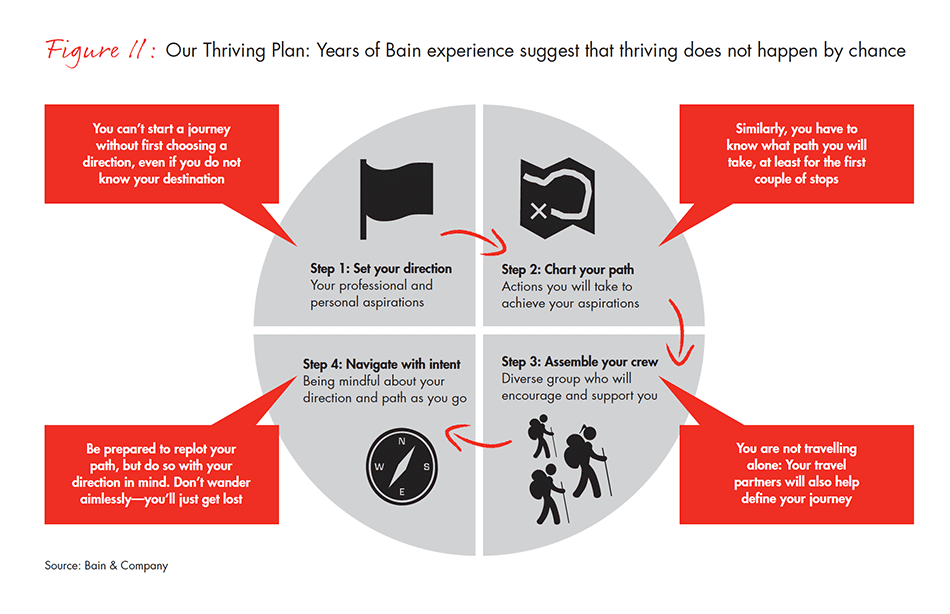
Thriving requires ongoing navigation with intent. It is not enough to develop a plan and assume that it will go perfectly. Over a long-term career, many professional and personal events will require you to make decisions about how to continue to thrive. Those who do not actively ensure that they are staying on their “thriving path” often find that they have drifted off it.
Thriving is easier when you have the support of your “crew”—people whose experiences teach you valuable lessons, and who can provide you with objective perspectives, hold you accountable to your long-term priorities and goals, and support you both day to day and in moments of truth. We would advocate that individuals envision themselves as the CEO of their company and create a “Board”—a set of four to six people who will advise and guide them throughout their career. In addition to sponsors and mentors, crew members would include your “infrastructure”—this may comprise a range of different people (such as family and friends, religious leaders or domestic helpers).
“The Thriving Plan forced me to step back and take stock of my life holistically. The conversations that I’ve had since writing my plan have helped refine my vision and keep me on track. It has also allowed me to have the same structured conversations with my mentees,” emphasised a senior manager of a professional services firm.
Once you have completed your plan, seek additional means through which you can help other women. An executive in professional services explained, “There is a perception, which spans race and gender, that women aren’t always supportive of other women and their career progression. A good way to do this is to ask women about their Thriving Plan—what they are focusing on and how you can help—or offer to be part of someone’s crew.”
Women can reap the benefits of consciousness with their careers, taking a holistic view to ensure that they are thriving, not just succeeding.
Conclusion
Although South Africa has made significant strides towards gender equality in the workplace, the country still has a long way to go. Because of intersectionality, gender cannot be viewed on its own—a fact that is particularly important in the case of South Africa given its historical context. Gender equity is not solely a matter of chasing targets: Organisations need to set women up for success in order for them to reap the business benefits that diversity can bring.
Through this study, we’ve uncovered that organisational and societal factors, not personal ones, limit women’s ability to reach the top. Understanding, accommodating and celebrating diversity are challenging for all companies, but doing so pays off when done well. Within organisations, diversity efforts must begin at the top, with CEOs spearheading the changes, targeting the middle layer of the company (the talent pipeline) and tracking and measuring progress. That said, everyone has a role to play in changing the status quo, be it in his or her capacity as an individual, as an organisational leader or as a member of society.
What are you going to do differently on Monday morning? What will be your commitment to change?
Employee Net Promoter Score® explained
The Employee Net Promoter Score (eNPS) groups respondents into three categories: promoters, passives and detractors.
- Promoters (score of 9 or 10): People who feel that their lives have been enriched by their relationship with their organisation or leader. They behave like loyal employees, typically staying longer and talking the organisation up to their friends and colleagues.
- Passives (score of 7 or 8): People who are fairly satisfied employees, but not loyal ones. They rarely talk their company up, and when they do, it’s likely to be qualified and unenthusiastic. If a better offer comes along, they are likely to defect.
- Detractors (score of 0 through 6): People who feel their lives have been diminished by their association with their organisation or leader. They are dissatisfied and even dismayed by how they are treated. They frequently speak negatively about their organisation and are likely to leave as soon as they find something better.
NPS is calculated by subtracting the percentage of detractors from the percentage of promoters.
The CEO is fundamental in fostering gender equity
- Lead by example. Know that it all starts or fails with you. For instance, encourage your direct reports to develop at least one or two women as potential successors.
- Don’t divorce actions at work from those at home. Treat your employees with the same respect and empathy you would like afforded to your family.
- Seek advice. Work with those who have done it before.
- Understand your current reality. Use a diagnostic tool to accurately pinpoint the status of gender equity in your organisation. Talk to female employees; don’t just make assumptions about what they need and want. Have your desired endpoint in mind, and recognise that getting it right will require a journey.
- Have clear ambitions and targets. Establish targets, not necessarily quotas, and then track and implement consequences (both positive and negative), just as you would for financial targets. Culture-based metrics such as each employee’s NPS, combined with demographics and employee levels, would be a useful indicator of sentiment.
Profile of successful women and men in South Africa
Although there is no guaranteed or “typical” path to the top, our research and in-depth interviews uncovered a set of common themes, characteristics and behaviours of highly successful business leaders. Some of these include:
- working hard and always being willing to go the extra mile to be ahead of the game;
- having confidence, yet being humble about their capabilities;
- grabbing opportunities and taking risks;
- always finding ways to excel at every task and learning from mistakes;
- remaining curious, with a relentless desire to learn and try new things; and
- taking an interest in others.
Catalina Fajardo is a partner in Bain & Company’s Johannesburg office. She is a member of the firm’s Telecommunications, Media and Technology practice and also leads the firm’s Women@Bain efforts in South Africa. Maureen Erasmus is an advisory partner with Bain’s London and Johannesburg offices. She is a partner in the Financial Services practice, focusing on the capital markets and investment banking sector.
Net Promoter®, Net Promoter System®, Net Promoter Score® and NPS® are registered trademarks of Bain & Company, Inc., Fred Reichheld and Satmetrix Systems, Inc.
1 Senior leadership includes chief executive officers, managing directors, chairs and other senior-level decision makers.










